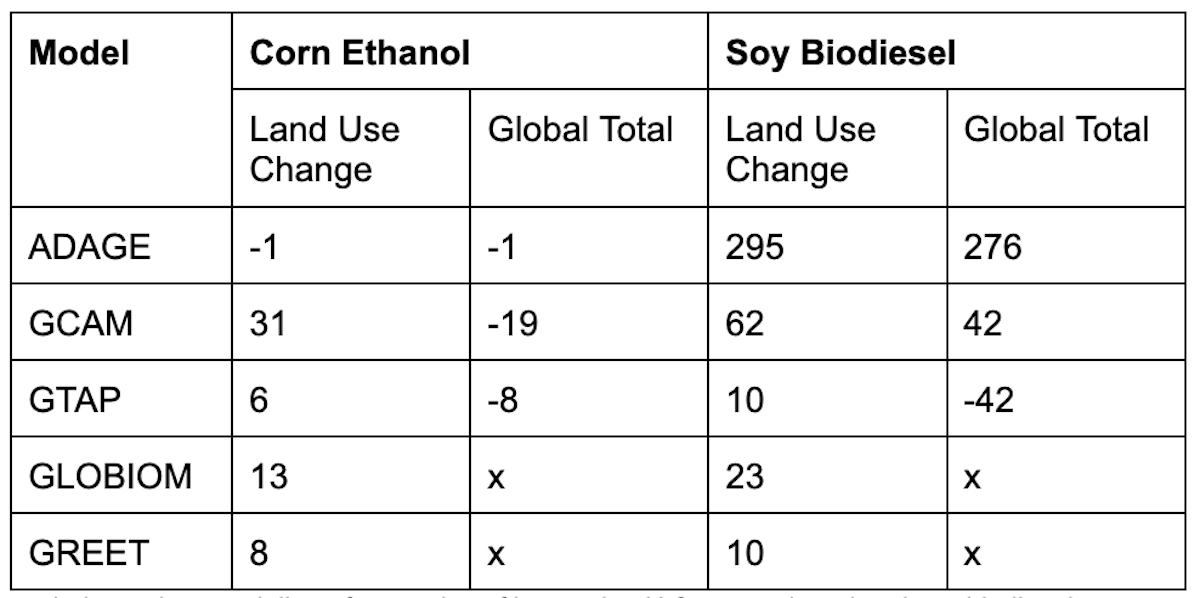Climate-Smart Biofuel is Coming
Without Safeguards, It Could Backfire

-
-
Share
-
Share via Twitter -
Share via Facebook -
Share via Email
-
As Americans increasingly turn to electric vehicles, corn and soy farmers have grown understandably worried: will demand tank for ethanol and soy-based biodiesel? Many are hoping to sell their crops to producers of so-called Sustainable Aviation Fuel, an alternative to conventional jet fuel. Corn ethanol and soy biodiesel generally have too large a carbon footprint to qualify for tax credits that support sustainable aviation fuel. But the Department of Agriculture is under pressure to allow some ethanol and other crop-based biofuels to qualify for generous federal and state tax credits meant to support clean fuel not only for jets, but for all modes of transportation.
Earlier this summer, the Department of Agriculture (USDA) announced that it is developing methods to estimate the greenhouse gas emissions of biofuels that are produced from crops grown using different farming practices, such as conservation tillage, cover crops, and more precise methods of fertilizer application. If a farmer uses enough of these practices, the USDA could estimate that biofuel made from their crops has a low enough carbon footprint to qualify for the Clean Fuel Production Credit (or 45Z credit) created in the Inflation Reduction Act, or a growing range of state-level clean fuel programs.
There’s just one problem—the entire effort could backfire and raise emissions. Paying farmers more to grow crops for biofuel will increase biofuel demand, which has well-known environmental risks. And if the USDA doesn’t quantify the climate impact of farming practices in a comprehensive and accurate manner—which they arguably lack the data to do—they could underestimate the carbon footprint of biofuels and undermine clean fuel programs.
Expanding the Biofuel Market: A Double-Edged Sword
The USDA's initiative rests on a simple premise: accounting for the climate benefits of farming practices will let farmers sell more of their crops into biofuel markets and get paid more for them. Consider the Clean Fuel Production Credit for example. Starting January 2025, biofuel producers can receive a federal tax credit up to $1.00 per gallon for non-aviation fuel and $1.75 per gallon for SAF (adjusted annually for inflation). However, the fuel must have a carbon footprint below 50 kg CO₂e per million BTU, and producers receive a larger tax credit the smaller the footprint is. If the USDA’s carbon footprint calculations are adopted for the tax credit, fuels produced from crops grown using climate-smart practices will be more likely to qualify for the credit or receive a larger credit. Although the tax credit can only be claimed by fuel producers, its benefits are widely expected to trickle down to farmers as they demand to be paid more for low-carbon crops.
If the USDA’s efforts work as planned and farmers have access to new biofuel revenue streams, production of crop-based biofuels will increase. Though this may increase farm income, it would risk increasing greenhouse gas emissions in two ways.
First, providing greater financial incentives to companies to produce crop-based biofuels could divert demand from other biofuels – such as those made from agricultural residues (like corn stalks and other material left after harvest), food waste (like used cooking oil), or from forest residues and other woody biomass. These generally have a lower carbon footprint and often already qualify for tax credits. Therefore, shifting toward more crop-based biofuels risks increasing overall emissions as corn and soy dominate the market.
Second, as demand for crop-based biofuels grows, so does the amount of land they take up. Previous increases in U.S. corn ethanol production have led to the conversion of millions of acres of land, both in the U.S. to produce enough feedstock and internationally to replace U.S. corn exports that fell due to the biofuel boom. Though it's widely acknowledged that crop-based biofuels lead to land use change, researchers disagree on the extent.
As the Environmental Protection Agency (EPA) has noted, some models estimate that the resulting land-use change is so large that it negates most or all of the climate benefits from replacing gasoline and other fossil fuels with corn ethanol or soy biodiesel. The EPA’s recent comparison of models found that increased corn ethanol and soy biodiesel demand could lead to higher emissions, partially due to land-use changes. While corn production might see minimal emission reductions, soybean cultivation could result in substantial emission increases (Table 1).
Table 1: GHG emissions impacts of corn ethanol and soy biodiesel (kgCO2eq/MMBTU) estimated by each model

Even if the true GHG impact of biofuels is on the lower end of estimates and they save emissions, rewarding biofuel producers and farmers for specific farming practices could backfire. Overestimating the climate benefit of farming practices—and the feedstocks grown with them—could distort the biofuel market, giving some crop-based fuels an unwarranted advantage. This would crowd out other fuels that actually have lower emissions and undermine the goals of clean fuel programs. It is critical for the USDA and its partners to take a comprehensive approach in accounting for the effects of low-carbon fuel incentives on farming, particularly soil carbon sequestration, crop yields, and farmers’ decision-making.
The Mirage of Soil Carbon Sequestration
Many farming practices are considered climate-smart on the grounds that they suck carbon dioxide out of the air and store it in the soil. But soil carbon sequestration is often overstated and transient. Any quantification of the benefits of climate-smart farming practices must account for the limitations and uncertainties involved.
Practices like no-till farming, cover cropping, and compost application can enhance soil carbon levels, but these gains are often temporary. Stopping these practices or disturbing the soil through tillage, which remains common, releases stored carbon back into the atmosphere. The USDA estimates that over half of acres of corn, soy, wheat, and cotton where no-till or strip-till was practiced in a four-year period were fully tilled in at least one of the years. Similarly, the USDA reports that cover crop adoption is often inconsistent. For example, on nearly half of the corn and soybean acres where cover crops were planted over a four-year period, they were only planted in one of those years. Warming temperatures are also expected to release greater amounts of soil carbon in the future, potentially reducing the effectiveness of farming practices in storing carbon.
In addition, even the short-term climate benefits of soil carbon sequestration are often overestimated. A review of U.S. cover crop studies found no significant increase in soil carbon sequestration in most cases. Even when increases were observed, they varied widely, highlighting the unpredictability of these practices. Estimates also often don’t account for new emissions generated by adopting climate-smart farming practices, such as greenhouse gas emissions released from growing and planting cover crop seeds.
The USDA and others must be conservative in estimating the soil carbon benefits of farming practices. Inflated estimates carry a large risk; it could lead to some crop-based biofuels qualifying for low-carbon fuel incentives that they shouldn’t receive, distorting the market, and giving them an unfair advantage over other fuels that actually have a lower carbon footprint.
The Yield Trap
Alarmingly, some of the farming practices that clean fuel tax credits could incentivize under the USDA’s framework—such as cover cropping—often reduce crop yields, potentially offsetting much or all of their expected climate benefit. Lower yields mean more land is needed elsewhere to make up for lost productivity, pushing agricultural expansion into forests and grasslands. This land-use change releases stored carbon, negating the climate benefits of these practices, and throwing into question whether they should help crop-based biofuels qualify for tax credits.
For instance, cover crops typically reduce corn yields by up to 5.5% and soy yields by 3.5% in the Corn Belt—seemingly small numbers with significant impacts when scaled. This yield reduction results in indirect land-use change, potentially generating nearly as much or more emissions than those saved by the practices. One paper estimated that a sustained reduction in corn productivity of this scale would lead to 1.4 Gt CO₂e from land-use change, equating to more than double the entire greenhouse gas emissions produced by U.S. agriculture annually.
Conversely, practices that increase yields can spare land, helping reduce land use and related emissions. Recent research, for example, found that no-till farming has increased yields of rainfed corn by nearly 10% in Nebraska, the Dakotas, and Kansas.
Accounting for the impact of farming practices on yields is therefore critical when estimating their effect on emissions. Overlook this, and efforts to support climate-smart biofuels may do just the opposite, reducing yields and further increasing the land use footprint of biofuels.
Avoiding Redundant Incentives: Why Additionality Matters
As is best practice in climate programs, the USDA should also aim to ensure additionality. This principle in carbon accounting requires that emissions reductions are only credited when they result directly from the initiative. If farmers are already adopting climate-smart practices due to existing incentives or other motivations, the USDA’s efforts may not generate additional climate benefits.
Think of additionality like offering a coupon to encourage a customer to buy something. If the customer was already planning to buy the item, the coupon doesn’t drive new behavior—it merely rewards what was going to happen anyway, wasting money. Similarly, if USDA and clean fuel programs incentivize practices that farmers would have adopted regardless—whether due to state-level incentives, market trends, or financial benefits—their efforts won’t reduce emissions.
Multiple studies have found that federal incentives for farmers to adopt environmentally beneficial practices are not entirely additional and that incentives for specific practices, like no-till, are particularly redundant. Without trying to ensure additionality, the USDA would risk subsidizing the inevitable, wasting resources that could be better spent elsewhere.
Recommendations
Any effort that expands demand for crop-based biofuels may drive enough land conversion to increase overall emissions. Decades after kicking off the biofuel boom, the EPA still can’t provide a definitive answer. Despite the lack of evidence that accounting for farming practices when calculating the carbon intensity of biofuels will benefit the climate, the USDA will presumably implement such accounting anyway. In accounting for the effects of farming practices on biofuels’ carbon footprint, the USDA, Congress, and other stakeholders can take several steps to minimize emissions:
Conservative accounting: The USDA should take a conservative and comprehensive approach in its efforts to establish standards for biofuel feedstocks grown with climate-smart practices. Accounting methods should consider additionality, soil carbon sequestration, emissions associated with the entire life-cycle of a practice, yields, and any farmland expansion or land conversion resulting from changes in yields.
Exclude temporary carbon sequestration: When identifying practices that could reduce the carbon footprint of producing biofuel feedstocks, the USDA should exclude practices whose primary climate benefit is soil organic carbon sequestration with low durability, such as no-till and non-legume cover cropping. The USDA should, however, consider including practices that can durably increase soil carbon, such as applying inorganic carbon (i.e. enhanced rock weathering) and biochar.
Research: Congress should continue to support USDA efforts to quantify, track, and evaluate the effects of farming practices on soil carbon and greenhouse gas emissions.
Evaluation: Congress and the environmental community should hold the USDA accountable to periodically evaluate and update its quantification of the effects of farming practices. The Administration should also fund third-party analyses of the Clean Fuel Production Credit and other clean fuel programs that provide a sufficiently detailed assessment to make improvements.
The stakes are too high to rely on outdated or incomplete data. The USDA must ensure its climate accounting is thorough, conservative, and grounded in the latest research. Close coordination with the Treasury on 45Z tax credit implementation—and with state agencies on other clean fuel credits—is essential to ensure biofuel incentives drive real emissions reductions rather than undermine climate goals.

